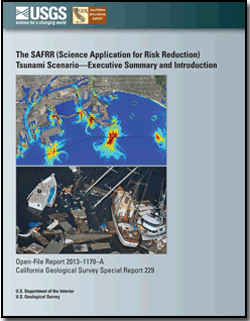Skip Links
USGS Open-File Report 2013–1170 and CGS Special Report 229, Chapter A
The SAFRR (Science Application for Risk Reduction) Tsunami Scenario—Executive Summary and Introduction
By Stephanie L. Ross, Lucile M. Jones, Kevin Miller, Keith A. Porter, Anne Wein, Rick I. Wilson, Bohyun Bahng, Aggeliki Barberopoulou, Jose C. Borrero, Deborah M. Brosnan, John T. Bwarie, Eric L. Geist, Laurie A. Johnson, Stephen H. Kirby, William R. Knight, Kate Long, Patrick Lynett, Carl E. Mortensen, Dmitry J. Nicolsky, Suzanne C. Perry, Geoffrey S. Plumlee, Charles R. Real, Kenneth Ryan, Elena Suleimani, Hong Kie Thio, Vasily V. Titov, Paul M. Whitmore, and Nathan J. Wood
 Summary Summary
The Science Application for Risk Reduction (SAFRR) tsunami scenario depicts a hypothetical but plausible tsunami created by an earthquake offshore from the Alaska Peninsula and its impacts on the California coast. The tsunami scenario is a collaboration between the U.S. Geological Survey (USGS), the California Geological Survey, the California Governor’s Office of Emergency Services (Cal OES), the National Oceanic and Atmospheric Administration (NOAA), other Federal, State, County, and local agencies, private companies, and academic and other institutions. This document presents evidence for past tsunamis, the scientific basis for the source, likely inundation areas, current velocities in key ports and harbors, physical damage and repair costs, economic consequences, environmental and ecological impacts, social vulnerability, emergency management and evacuation challenges, and policy implications for California associated with this hypothetical tsunami. We also discuss ongoing mitigation efforts by the State of California and new communication products. The intended users are those who need to make mitigation decisions before future tsunamis, and those who will need to make rapid decisions during tsunami events. The results of the tsunami scenario will help managers understand the context and consequences of their decisions and how they may improve preparedness and response. An evaluation component will assess the effectiveness of the scenario process for target stakeholders in a separate report to improve similar efforts in the future.
|
First posted September 3, 2013
This report is presented in Portable Document Format (PDF); the latest version of Adobe Reader or similar software is required to view it. Download the latest version of Adobe Reader, free of charge. |
Suggested citation:
Ross, S.L., Jones, L.M., Miller, Kevin, P., K.A., Wein, A., Wilson, Ri.I., Bahng, B., Barberopoulou, A., Borrero, J.C., Brosnan, D.M., Bwarie, J.T., Geist, E.L., Johnson, L.A., Kirby, S.H., Knight, W.R., Long, K., Lynett, P., Mortensen, C.E., Nicolsky, D.J., Perry, S.C., Plumlee, G.S., Real, C.R., Ryan, K., Suleimani, E., Thio, H., Titov, V.V., Whitmore, P.M. and Wood, N.J., 2013, SAFRR (Science Application for Risk Reduction) Tsunami Scenario—Executive Summary and Introduction: U.S. Geological Survey Open-File Report 2013–1170–A, in Ross, S.L., and Jones, L.M., eds., The SAFRR (Science Application for Risk Reduction) Tsunami Scenario: U.S. Geological Survey Open-File Report 2013–1170, 17 p., http://pubs.usgs.gov/of/2013/1170/a/.
Contents
Contributors
Executive Summary
Introduction
Acknowledgments
References